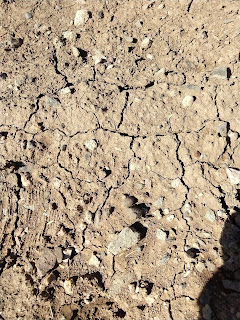Sediment Transportation
This week was somewhat of a challenge for me. Let me take you on my adventure.
First I went to a mountain walkway that gets a lot of wind. I thought I might find a wind swept boulder. Problem is, the area has gone through a lot of renovation by local parka and rec. The ground is covered in volcanic rock from when the path was actually a railroad track. The boulders were placed there for safety recently, and there isn't much bare soil. It's all covered in plant life.
I did found this
It isn't very well sorted. Most likely due to human interference. It's a high traffic area. It has some larger rocks in it from gravel being thrown in to make it passable for hikers. We had a lot of rain lately; it rained for two days straight in drizzle and downpour. The soil's top is cracked from drying out yesterday and this morning. Despite the presence of fine grained clay, I don't think this is here by wind, but rather by water. This spot gets muddy every time it rains and takes days to dry enough for people to transverse around it. However, it does have similar characteristics to a wind blown sediment, except for the larger rocks. The clay that is here is pretty fine. It is well sorted from it's trip down the mountain. If this were cemented into a rock it would become a mudstone conglomerate.
Next in my search I thought of the tailings from the mine. Unfortunately with our deep soaking rain, it isn't at all interesting for my intents and purposes. When it is dry and windy a cloud of sediment will float from this and be carried all over town. At times the air quality can be quite poor. However, the mine does a good job trying to prevent this from happening often. They will spray it with water to keep the dust down.
The tailings is a mix of all kinds of ground rock from the processed material in the mine. They take out the copper ore and leave the rest. It is then chemically altered as well when they run solution through the pile to further collect any copper they can. If it were a rock it would be an interesting mix for sure. Maybe a sandstone, the grains are angular with a coarse, sandy texture.
I searched for a sand place that I thought might be influences by wind, but the only place I could think of is the silty sand down by the river. It has been flowing pretty low for a couple years, so I figured it was worth a shot. I can't tell if these divots are an indication of wind movement. You can see they have been rain splattered, so there isn't any kind of definite saltation or upwind and downwind movement. What could it be otherwise?
Big horned sheep are everywhere. They become a problem because their large herds are all over town.
 Game and fish come out once a year to collect and relocate them. It is possible the marks in the sand are from them. At any rate, if this silty fine sediment were to become a rock it would be siltstone.
Game and fish come out once a year to collect and relocate them. It is possible the marks in the sand are from them. At any rate, if this silty fine sediment were to become a rock it would be siltstone.I couldn't think of anywhere else to look for proof of sediment transportation. The rain wiped out a lot with the force of the water running down the steep slopes of the mountain, so any build up was washed away, as well as wind ripples across any loose sediment. We have a good deal of grass and vegetation in town, so the wind doesn't carry much away. As I was driving I was thinking how much my car needs a wash and then it hit me. My car is proof of sediment transportation.
These fine particles of clay and silt were carried onto my car by wind. When it rained the splatters formed the particles into dirty raindrops on my car. Why, I ask myself, could it not rain hard enough to wash the dirt away? Regardless, we see proof all around us, even when we have to wash our cars and dust our houses. Sediment is carried in fine particles just about everywhere we go.
Interestingly enough, even Egyptian mummies teeth show signs of wear from eating grains of sediment in their food over time. So you can see, sediment is carried just about everywhere by wind.







Comments
Post a Comment